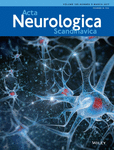Cervical cord and ventricle affection in neuromyelitis optica
Abstract
Objectives
Cervical cord involvement is common in neuromyelitis optica (NMO) and multiple sclerosis (MS), but its impact on disability in NMO has rarely been studied. Recent publications on NMO examined the periventricular system, areas of high aquaporin-4 expression, but not yet by using ventricle volumetry.
Purpose
To compare cervical cord atrophy, ventricular widening, and supra- and infratentorial brain measures between NMO and MS, and study their impact on clinical disability.
Methods
Magnet resonance imaging-based volumetry of upper cervical cord, third and fourth lateral ventricles, grey matter, white matter, brainstem, cerebellum and clinical status of 18 NMO and 20 MS patients, was compared between the groups and with 26 healthy controls. Patterns of ventricular widening relative to healthy controls were inspected by voxel-based morphometry of the cerebrospinal fluid.
Results
Cervical cord atrophy was similar in NMO and MS (75.2 ± 10.0 mm2, respectively, 76.5 ± 9.5 mm2 vs 84.1 ± 8.6 mm2 in controls).Third ventricle increase in both groups, and specific fourth ventricle widening in MS were detected. Patient groups differed in third to fourth ventricle ratio (P = 0.002). In NMO, white matter correlated inversely with the affected cord segments (P = 0.001) and with cervical cord area (P = 0.043). The disability status was explained by cervical cord area and third ventricle volume (R2=0.524) in NMO, and by grey matter and fourth ventricle volume (R2=0.565) in MS.
Conclusion
Cervical cord atrophy and third ventricular enlargement are both clinically relevant in NMO. Third and fourth ventricle volumetry shows differences between NMO and MS regarding the involvement of periventricular structures.




